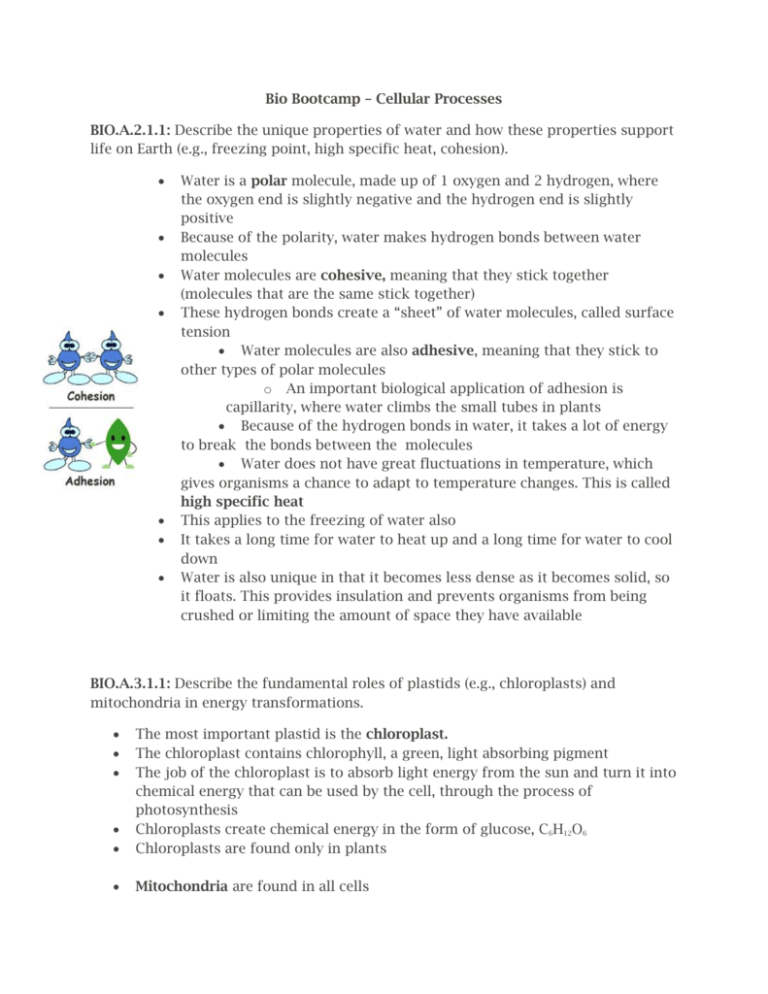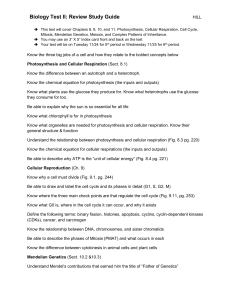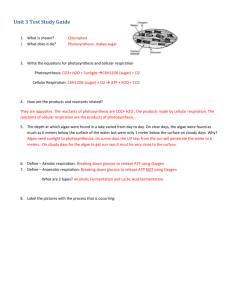Review Guide Cellular Processes
advertisement

Bio Bootcamp – Cellular Processes BIO.A.2.1.1: Describe the unique properties of water and how these properties support life on Earth (e.g., freezing point, high specific heat, cohesion). Water is a polar molecule, made up of 1 oxygen and 2 hydrogen, where the oxygen end is slightly negative and the hydrogen end is slightly positive Because of the polarity, water makes hydrogen bonds between water molecules Water molecules are cohesive, meaning that they stick together (molecules that are the same stick together) These hydrogen bonds create a “sheet” of water molecules, called surface tension Water molecules are also adhesive, meaning that they stick to other types of polar molecules o An important biological application of adhesion is capillarity, where water climbs the small tubes in plants Because of the hydrogen bonds in water, it takes a lot of energy to break the bonds between the molecules Water does not have great fluctuations in temperature, which gives organisms a chance to adapt to temperature changes. This is called high specific heat This applies to the freezing of water also It takes a long time for water to heat up and a long time for water to cool down Water is also unique in that it becomes less dense as it becomes solid, so it floats. This provides insulation and prevents organisms from being crushed or limiting the amount of space they have available BIO.A.3.1.1: Describe the fundamental roles of plastids (e.g., chloroplasts) and mitochondria in energy transformations. The most important plastid is the chloroplast. The chloroplast contains chlorophyll, a green, light absorbing pigment The job of the chloroplast is to absorb light energy from the sun and turn it into chemical energy that can be used by the cell, through the process of photosynthesis Chloroplasts create chemical energy in the form of glucose, C6H12O6 Chloroplasts are found only in plants Mitochondria are found in all cells Mitochondria take the glucose that is formed in photosynthesis and break it down into a useable form of energy This useable form of energy is ATP This conversion of glucose into ATP occurs in the process of cellular respiration Cells which require a lot of energy, such as muscle and sperm cells, have a lot of mitochondria BIO.A.3.2.2: Describe the role of ATP in biochemical reactions. ATP is adenosine triphosphate, a molecule that is used by the cell as energy currency This is a cyclical molecules whose only job is to act as energy storage and release – in fact ANY reaction that requires energy in the body will use ATP It stores energy in a bond between the 2nd and 3rd phosphate By removing the phosphate, energy is released By adding the phosphate, energy is stored. BIO.A.3.2.1: Compare and contrast the basic transformation of energy during photosynthesis and cellular respiration. Photosynthesis is the process of changing light energy, from the sun, into chemical energy, in the form of glucose C6H12O6 Photosynthesis occurs in plants and other organisms that contain chloroplasts These organisms are called autotrophs These organisms are always green in color Photosynthesis requires the input of sunlight, carbon dioxide and water Photosynthesis create glucose and oxygen The most important product for the plant / the goal of photosynthesis is glucose – energy is stored in the bonds of the molecule Oxygen is a by product; however oxygen is important for us Energy in the form of light enters and is changed into and stored as chemical energy Glucose is a high energy molecule. In fact, if the body tried to directly use glucose, too much would be lost Cellular respiration is the process of breaking glucose into ATP, which is a more useable form Cellular respiration takes in glucose and oxygen and creates ATP, water, and carbon dioxide ATP is the main product of respiration All organisms undergo cellular respiration Energy in the form of glucose enters and is broken into smaller chunks and stored in the bonds of ATP Photosynthesis and cellular respiration are dependent cycles of each other. o o o They both recycle oxygen and carbon dioxide Both are multistep processes that transform energy from one form into another Both use the same basic materials – what is the by product of one becomes the starting material for the other BIO.B.1.1.1: Describe the events that occur during the cell cycle: interphase, nuclear division (i.e., mitosis or meiosis), cytokinesis. BIO.B.1.1.2: Compare and contrast the processes and outcomes of mitotic and meiotic nuclear divisions. The cell cycle could also be called the cell’s life cycle Interphase is the time of normal cell activities Interphase is the longest portion of the cell cycle (cell life) Interphase is also the time in which the cell prepares for cell division, including making copies of the DNA (replication) Nuclear division is divided into 2 types: mitosis and meiosis Mitosis is the process that makes copies of the cell that are identical to the original The purpose of mitosis is for growth of an organism and repair of existing damaged cells Mitosis is triggered when the cell becomes too big to work efficiently Mitosis is divided into 4 stages o Prophase is where the DNA condenses into chromosomes, the nuclear membrane disappears, and the centromeres move to opposite ends of the cell with the spindle between them o Metaphase is where the chromosomes line up in the middle o Anaphase is where the identical chromatids break apart and move to opposite ends o Telophase is where the steps of prophase reverse themselves The result of mitosis is 2 daughter cells that are smaller but otherwise identical to the original Meiosis is a similar process to mitosis that creates reproductive cells, gonads (sperm or egg) Meiosis is divided into meiosis I and meiosis II. o The steps of meiosis are prophase I, metaphase I, anaphase I, and telophase I o The steps of meiosis II are prophase II, metaphase II, anaphase II, and telophase II o Prophase generally has the same look, metaphase is always in the middle, etc o o o The biggest difference between mitosis and meiosis is in prophase I where the process of crossing over occurs. Crossing over is when 2 homologous (same size and type) chromosomes join together in a structure called a tetrad and exchange genetic material; Crossing over allows for new combinations of genes in the offspring The result of meiosis is 4 daughter cells that have half the genetic material of the original. This genetic material is different from the genetic material that went in to the start of the process Cytokinesis is the process that follows both mitosis and meiosis, Cytokinesis is the division of the cytoplasm and cell organelles In animal cells, the cell pinches in to separate the new cells In plant cells, a wall is built between the cells








